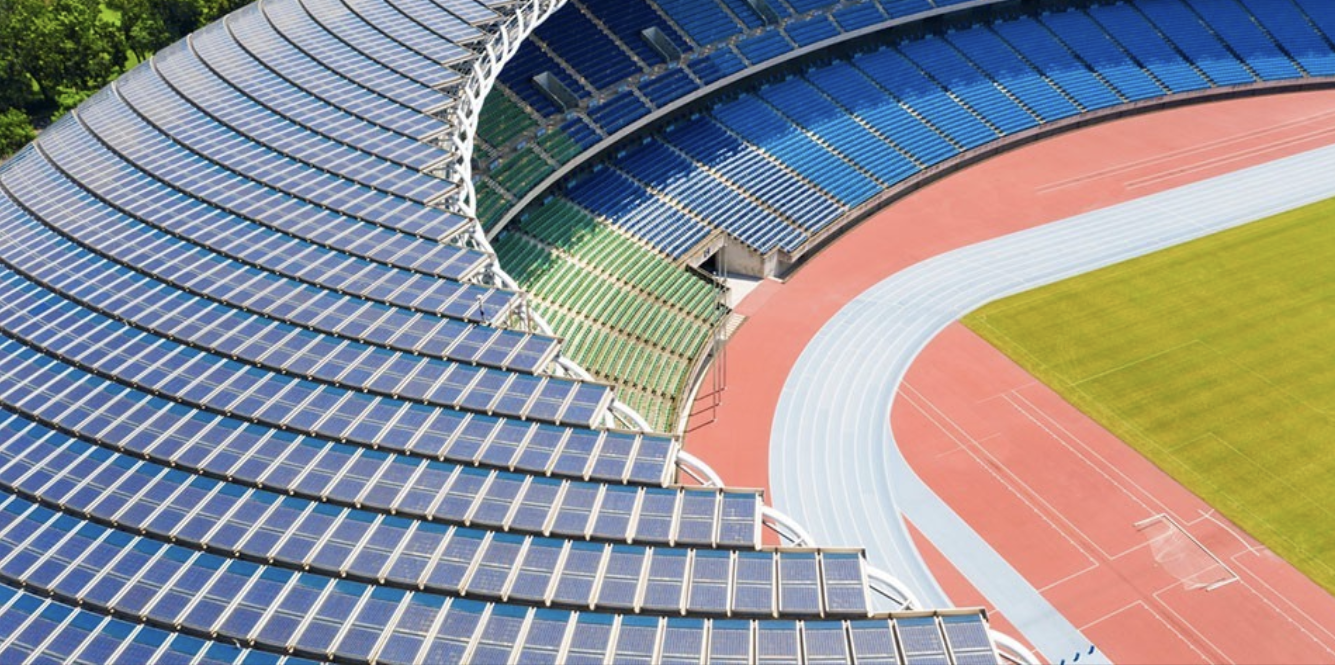
We’re used to thinking about innovation in terms of AI and digital tools, but one of the most pressing and often overlooked arenas of transformation in sports is environmental. As climate impact intensifies, stadiums are emerging as key players in the sustainability revolution.
Today’s sports venues aren’t just hosting matches, but they’re becoming high-tech ecosystems that use renewable energy, reduce waste, optimise resources, and engage fans in greener behaviour. In this article, we spotlight the rise of “green stadiums” and the technologies driving this critical shift.
Historically, sustainability has been a secondary concern in sport, overshadowed by performance, broadcast rights, and commercial growth. But that’s changing fast. High-profile climate commitments by major leagues (e.g. UEFA’s sustainability strategy, the IOC’s carbon goals) and fan pressure are pushing clubs and franchises to rethink how they build and operate their venues.
Sports facilities are massive energy consumers: powering floodlights, giant screens, Heating, Ventilation, and Air Conditioning (HVAC) systems, and more. On game day, a major stadium can consume as much energy as a small town. Waste generation and water usage also spike during events. With mounting scrutiny from regulators and fans alike, the need for green innovation is urgent.
Fortunately, some sports venues are already leading the way. State-of-the-art examples like Tottenham Hotspur Stadium, Climate Pledge Arena (Seattle), and Allianz Arena (Munich) showcase what’s possible when sustainability and technology converge. As the Premier League’s greenest club, Tottenham Hotspur is committed to minimising the environmental impact of its operations, with a key focus on the sustainable delivery of events at the stadium.
From rooftop solar panels and rainwater harvesting systems to advanced building management software and AI-driven energy optimisation, these facilities are showing the way forward. They’re not only reducing emissions but they’re cutting costs and improving operational resilience.
This matters because stadiums can serve as high-visibility sustainability beacons. A club’s green efforts resonate far beyond the venue, educating fans, influencing sponsors, and elevating brand equity.
Not every club has the budget of an NFL franchise or a European superclub. But green stadium technology is increasingly modular and scalable. Simple integrations like LED retrofits, composting systems, motion-sensor lighting, and low-flow water fixtures offer affordable ways to make an immediate impact.
Cloud-based tools help venue managers monitor energy use and carbon intensity in real time, offering actionable insights without the need for in-house sustainability experts.
The Green Sports Alliance and other networks also offer templates and shared learnings to accelerate action.
The path to a green stadium doesn’t require tearing everything down and starting from scratch. The key is identifying low-hanging fruit and using data to track progress.
Some starting points:
Energy: Transition to renewable power sources, or use AI to optimise lighting and HVAC based on occupancy.
Materials: Use recycled or low-carbon materials in construction and refurbishments.
Waste: Deploy smart bins to sort waste automatically and incentivise fan behaviour.
Transport: Promote public transport access, electric vehicle charging, and bike infrastructure.
Like all transformations, it begins with measurement. Conducting a venue-wide environmental audit is the first step to prioritising changes and attracting investment or public funding.
Sustainability is no longer optional. Governments are tightening regulations on emissions and waste. Sponsors increasingly expect credible ESG strategies; and fans, especially younger ones, care about climate impact more than ever.
The next five years will see a sharp divide between venues that adapt and those that fall behind. Those who move now can benefit from tax incentives, green bonds, and early reputation gains. Crucially, a sustainable stadium can also become a revenue generator: reduced energy bills, enhanced sponsorship appeal, and stronger community partnerships.
It’s worth remembering that the Paris 2024 Olympic venues were being held to unprecedented sustainability standards, setting a new benchmark for future events. What was once niche is becoming norm.
As with any systemic shift, barriers exist. Capital expenditure is the biggest, especially for clubs with smaller operating budgets. Legacy infrastructure, resistance to change, and lack of in-house expertise are also common blockers.
But tech is making sustainability easier. Tools like carbon calculators, AI-driven maintenance schedules, and digital twins can forecast the ROI of eco-upgrades, making the business case clearer. Pilot projects such as smart water meters or energy optimisation software can demonstrate quick wins and unlock further funding.
The biggest risk is inertia. The biggest mistake: doing green upgrades without tracking their actual impact. Sustainability needs to be tied to performance metrics, just like attendance or merchandise sales.
The opportunity is here for those who move early
Green stadiums are not a niche concept anymore, they are the future of sports infrastructure. The tech exists, the urgency is real, and the benefits are tangible, from cost savings to reputational wins.
Sports teams have a unique platform to drive change, showing millions of fans what’s possible when environmental and athletic performance align.
Ready to take your sports start-up to the next level? Let's collaborate and redefine the game together.